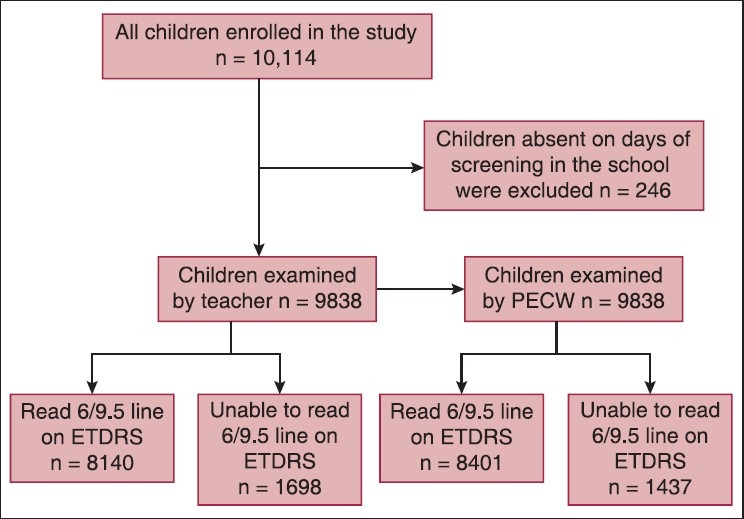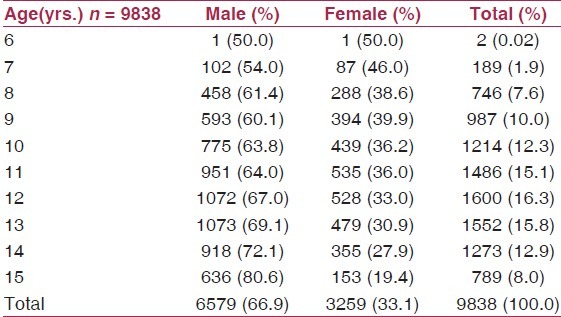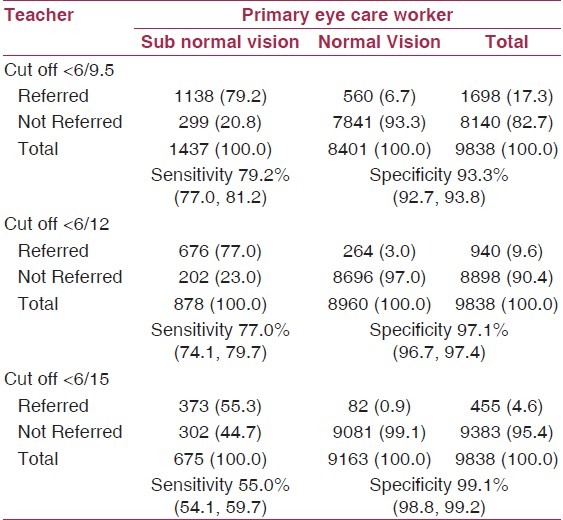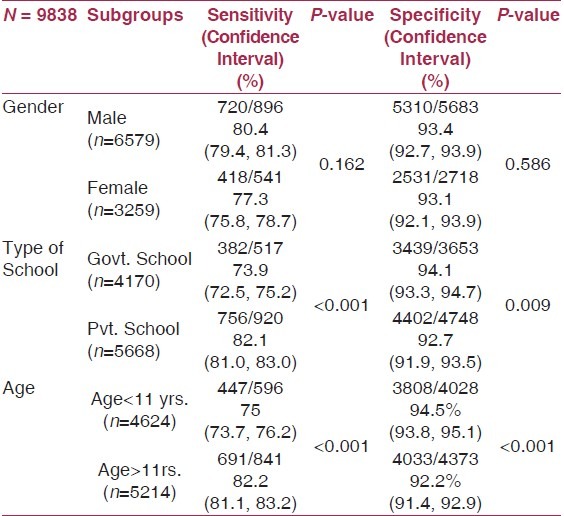Abstract
Background:
Although school eye screening is a major activity of the National Program for Control of Blindness, inadequate evidence exists about accuracy of school teachers in screening.
Objectives:
Compare quality of referral for subnormal vision by school teachers and primary eye care workers (PECW) in school children and to establish appropriate cutoff for identification of subnormal vision in school going children.
Materials and Methods:
This was a cross-sectional study involving school children studying in classes 1 to 9 in different schools of Delhi evaluated for sub-normal vision. Vision was recorded by the teacher and a primary eye care worker especially trained for the study using the optotypes of Early treatment Diabetic Retinopathy Survey (ETDRS) vision chart with standard lighting.
Results:
The total number of children enlisted in the 20 selected schools was 10,114. Of these, 9838 (97.3%) children were examined in the study. The mean age of children enrolled in the study was 11.6 ± 2.19 years with 6752 (66.9%) males. The sensitivity and specificity of teachers in comparison to PECW using 6/9.5 vision level as cutoff for referral was 79.2% and 93.3%, respectively compared to 77.0% and 97.1%, respectively on using the 6/12 optotype. The results showed significantly higher sensitivity and lower specificity for private schools against government schools and for older against younger children.
Conclusions:
Our results show that the use of teachers and shift to use of the 6/12 sized “E” for the school eye screening (SES) program is appropriate and would substantially reduce the work of eye care providers while improving its overall efficiency.
Keywords: Accuracy, national program for control of blindness, refractive errors, school eye screening, sensitivity and specificity
Introduction
Refractive error is one of the most common causes of visual impairment around the world and is the second leading cause of treatable blindness.(1) Although there is inadequate data on childhood blindness, population level surveys indicate childhood blindness in India to be 1.7/1000 (VA<6/60 in the better eye).(2) Studies have shown that much of the childhood blindness is treatable with refractive errors being the major cause (33.3%). It is also a major cause of visual impairment in children in India with prevalence of 61% in the rural population and 81.7% in the urban population.(3,4) Refractive error correction would result in benefit to >70% of the children who had bilateral vision impairment and in 50% of those with visual acuity of 20/40 or worse in at least one eye.(4) Thus, there is a significant unmet need for spectacles among school-aged children.
The school eye screening (SES) program was initiated under National Program for Control of Blindness (NPCB) in 1994.(5,6) It involves identification of schools, number of students and teachers, providing training of school teachers, screening of the children by teacher, examination and confirmation of the refractive error by an ophthalmic assistant/ophthalmologist, prescription of glasses and provision of free glasses to students from poor socioeconomic strata. The cost of SES component is borne by Government of India including provision of Rs 275/-for glasses for poor children through District Health Society funds NPCB 12th Plan 2012-17.(7)
Although SES is a major activity of the National Program for Control of Blindness (NPCB) and is a priority under the Sarva Shiksha Abhiyan, there is inadequate evidence in literature about the accuracy of school teachers in screening for subnormal vision in children. Among the possible problems of the SES could be low teacher motivation due to overwork, inadequate training of the teachers to assess the vision and errors in the examination process. The current cut off criterion for referring a child by the teacher to an optometrist as subnormal vision is 6/9.(5,6) If the child is unable to read the 6/9 letter on a tumbling “E” card then he/she is referred for further evaluation. Although previous papers have suggested evaluating higher cut off to 6/12 to reduce the number of false positives,(5,8) no evaluation of different cut offs for referral have been evaluated in any subsequent study.
The aim of the current study was to compare the accuracy of school teachers to trained primary eye care worker (PECW) in assessing the vision in 10,000 school children in class 1 to 9. We also assessed if changing the cut off for referral would affect the sensitivity and specificity of the procedure.
Materials and Methods
This was a cross-sectional study, in which 10,000 children studying in different schools of Delhi were screened for sub-normal vision. The study was approved by the institutional scientific ethics committee and followed the tenets of the Declaration of Helsinki for biomedical research. The study was carried out over a period of 1 year from July 2012 to June 2013. Examination was done during school hours. List of all the schools registered with the Government of Delhi in 2 districts of Delhi was taken and 10 schools were randomly selected from each district. Two distinct types of schools were listed: MCD/Delhi Administration/Government-aided schools and private-funded schools. This distinction between schools was made, as there is a difference in the socio-economic status (SES) of the children attending these schools. Permission for conducting the study in the selected schools was taken from the District Education Authority. All the children studying in classes 1 to 9 in the school were enrolled in the study. A letter explaining the entire screening procedure was sent to all the parents along with an informed consent form for the procedure. The vision of the child was recorded by the teacher and a primary eye care worker especially trained for the study using the optotypes of the early treatment diabetic retinopathy survey (ETDRS) vision chart with standard lighting. The chart has 5 “E” in various positions and the child had to accurately identify the direction of 4 of the 5 “E” in that particular letter size to have deemed to have correctly read the line.
Training of teachers for vision screening
The Principal of each school was asked to nominate 2 teachers, preferably one of them a female science teacher, who is already wearing spectacles. It was felt that they may be best suited to motivate children specially girls for wearing spectacles. The teachers were trained to conduct vision screening of the students using modified ETDRS chart (having 4 lines of ETDRS from 6/9.5 to 6/19) to be read at 4 meters under standard daylight illumination. The training was carried out for 40 teachers of the 20 schools selected in the 2 districts.
Before the start of the examination process in the school, all the teachers who would be participating in the screening process were collectively explained the procedure of evaluation and the steps were explained to them. Any doubts or queries of the teachers were cleared and the tools for vision screening demonstrated to them. All teachers were asked to fill the demographic details of the children followed by vision screening. The vision level of the child measured by the teacher was recorded as line read by the child. The visual acuity was taken with either eye closed with the palm of the hand.
Vision screening by trained primary eye care worker
After the teacher had recorded the vision of the child, a primary eye care worker trained for the study independently recorded the exact vision of all the children using the ETDRS vision chart. He/she was unaware of the findings of the teacher. The primary eye care worker had been especially trained in primary eye care at a tertiary eye care facility by the faculty in the department of Community Ophthalmology. The duration of training was 1 month with 1 year of experience in the field as a part of community-based project and in the tertiary eye care facility. The visual acuity was taken with either eye closed with the palm of the hand under standard daylight illumination. Test reproducibility in the study was improved by standardization of the training received by the PECW, regular retraining, having a uniform standard procedure for assessment of subjects and all PECW having the same testing material.
This study was a part of a school-based survey to assess the magnitude of refractive errors in children and the sample size was estimated for that study. The methodology of the study was suitably planned to collect this data during the course of that study [Figure 1].
Figure 1.

Flowchart showing the examination of children, the order of test execution and the number of patients undergoing the evaluation and outcome of the test for 6/9.5 vision level as cut-off. The other vision level as cut-off i.e. 6/12 and 6/15 had similar methodology
Analysis
The data was entered in specially designed Microsoft Access based software for the study. The sensitivity and specificity of the teachers compared with the PECW was computed for all children for the various visual acuity levels evaluated (6/9.5, 6/12, 6/15) along with their confidence intervals. Sub groups were made for different age groups (primary vs. secondary), gender and type of school (government vs. private school). The sensitivity and specificity were also calculated for the various sub groups. Probability (P) value of <0.05 was taken as significant. Data analysis was carried out using Stata 12.0 (Stata, College Station, Texas).
Results
The total number of children enlisted in the 20 selected schools was 10,114. Of these, 9838 children were examined in the study (response rate of 97.3%). The remaining could not be evaluated as they were absent on all the days and the vision screening was done in that particular school. The mean age of children enrolled in the study was: 11.6 ± 2.2 years with 6579 (66.9%) being boys. The age and gender distribution of the study population is given in Table 1.
Table 1.
The age and gender distribution of the study population

Using 6/9.5 as cutoff, the sensitivity and specificity of teachers in comparison with primary eye care workers were 79.2% and 93.3%, respectively compared to 77.0% and 97.1% respectively on using the 6/12 optotype. The comparison of identification of subnormal vision, for referral by teacher against the primary eye care worker for the various visual acuity cutoffs along with the sensitivity and specificity is given in Table 2. Using 6/9.5 vision level as cutoff for referral, 560 (6.7%) children were incorrectly referred by the teachers as having subnormal vision (false positives) as compared to 264 (3.0%) false positives using 6/12 as cut offs.
Table 2.
Comparison of the teacher versus primary eye care worker for the various visual acuity cutoffs taken along with the sensitivity and specificity and their Confidence Intervals (CI)

Sub groups were made for different age groups (primary vs. secondary), gender and type of school (government vs. private school) and the comparison of referral for children with subnormal vision using 6/9.5 as cutoff by teacher for the sub groups is given in Table 3. The results show significantly higher sensitivity and lower specificity for private schools against government schools and for older age group children against younger age group children. There was no significant difference for gender observed in the study.
Table 3.
Comparison of referral for children with subnormal vision using 6/9.5 as cut off by teacher for different age groups, gender and type of school

Discussion
The school eye screening (SES) program is a major thrust area of the government with huge resources of the central and state government being used for funding it all over the country. The program has involved the school teachers to reduce the work load of the ophthalmic assistants and ophthalmologists and expand the coverage. The teachers are not paid any money for the screening and the motivation for the teachers is the satisfaction that this process adds to their efforts of improving the performance of their students and enhances their status.(6)
Although the simplicity of the program has resulted in wide coverage and acceptability, there is scant literature available about the accuracy of the teachers in picking up subnormal vision and comparing it with a trained eye care worker. Also, though Limberg et al., had suggested considering changes in the cutoff levels to improve the sensitivity rates and reduce the false positives,(5) it has not been properly evaluated.
The current study examined 9838 children with coverage of 97.3%, which was excellent coverage and trained 40 teachers for screening the children. In this study, we used the ETDRS chart instead of the Snellen's chart due to the numerous reported disadvantages of Snellen's chart including variability in the number of letters in a row, irregular and arbitrary progression of letter sizes between lines and difference in the legibility of the letters used. Some letters (eg, C, D, E, G, O) are easier to read than others (eg, A, J, L) resulting in high re-test variability. These short-comings are eliminated in the ETDRS chart and are reported to have low test re-test variability, especially for children.(9) For this reason, we preferred the ETDRS chart, which have the 6/9.5 line used in our study compared with 6/9 line on Snellen's which is used in the SES program. It is unlikely that this difference would have any significant effect on the results of the study and its observations about the SES program. In our study, there was a significant difference in the number of boys and girls enrolled into the study. Age wise gender distribution shows that there were a lower number of girls compared with boys in higher classes and this has resulted in the skewed gender ratio. As the study had a very high coverage rate so the difference observed was truly present in the schools examined. However, this distribution will not have any effect on the findings of the study as the process of examination and referral was the same for all children.
Using vision of <6/9.5 as cutoff for referral, the teachers had 560 children wrongly referred for subnormal vision. High false positives is detrimental to any screening program, as it adds time and cost component for evaluation by the optometrist as also adding to the cost of travel to the optometrist and the anxiety to the child, and the parents on the child being informed by the teacher that the child has subnormal eyesight. Moreover, there is loss of credibility of the teacher who loses motivation and of the screening program, if a child identified by the teacher is later informed that he was incorrectly referred as having subnormal vision by the teacher.
We observed that on using 6/12 vision level as cutoff for referral, the false positives come down (264 compared to 560) with 758 lesser referrals (44.6% reduction in the total referrals to the optometrist). This markedly lowers the workload of the optometrist ensuring that those children who are actually having a significant refractive error are assessed by the optometrist. Also, as this will identify only those children with significant refractive errors it will help in prioritization of the services to those that need it. It is unlikely that those who are prescribed glasses of less than 1 dioptre strength would regularly wear them, as they may be able to perform their routine functions equally well without them. A greater coverage of the program is possible with the same resources. In view of this, the results of our study show that the cutoff for referral to an optometrist should be at 6/12 instead of 6/9.
The results showed significantly higher sensitivity and lower specificity for private schools against government schools and for older age group children against younger age group children, though no difference for gender was observed.
Although use of trained health worker or an optometrist has been discussed as a possible alternative in previous papers,(5,6,8) using teachers is a cost-effective option. Other advantages of using teachers are that the teacher can be effective in motivating the parents and children for the subsequent visit to the optometrist and, would also be more effective in motivating the children for the regular use of glasses. Positive encouragement and acceptance by the teacher would reduce the possible ridicule and ostracism a child with glasses would face in the class. In view of the severe shortage of trained manpower involved in eye care,(10,11) use of teachers appears to be the most appropriate choice for this program.
It is however very important to have regular training for the teachers, so that they remain motivated and do not consider this as an additional workload.
To conclude, our results show that use of teachers and shift to use of the 6/12 sized “E” for the SES program appears to be appropriate and would substantially reduce the work of eye care providers while improving its overall accuracy.
We recommend use of the 6/12 sized “E” for the SES program and regular training of the teachers, so that they remain motivated and are able to maintain the high standards necessary for the success of this program.
Acknowledgment
This study was possible due to an educational grant by the Department of Science and Technology, Government of India.
Footnotes
Source of Support: Nil
Conflict of Interest: None declared.
References
- 1.Dandona R, Dandona L. Refractive error blindness. Bull World Health Organ. 2001;79:237–43. [PMC free article] [PubMed] [Google Scholar]
- 2.Dandona R, Dandona L. Childhood blindness in India: A population based perspective. Br J Ophthalmol. 2003;87:263–5. doi: 10.1136/bjo.87.3.263. [DOI] [PMC free article] [PubMed] [Google Scholar]
- 3.Murthy GV, Gupta SK, Ellwein LB, Muñoz SR, Pokharel GP, Sanga L, et al. Refractive error in children in an urban population in New Delhi. Invest Ophthalmol Vis Sci. 2002;43:623–31. [PubMed] [Google Scholar]
- 4.Dandona R, Dandona L, Srinivas M, Sahare P, Narsaiah S, Muñoz SR, et al. Refractive error in children in a rural population in India. Invest Ophthalmol Vis Sci. 2002;43:615–22. [PubMed] [Google Scholar]
- 5.Limburg H, Vaidyanathan K, Dalal HP. Cost-effective screening of schoolchildren for refractive errors. World Health Forum. 1995;16:173–8. [PubMed] [Google Scholar]
- 6.Limburg H, Kansara HT, d'Souza S. Results of school eye screening of 5.4 million children in India--a five-year follow-up study. Acta Ophthalmol Scand. 1999;77:310–4. doi: 10.1034/j.1600-0420.1999.770313.x. [DOI] [PubMed] [Google Scholar]
- 7. [Last accessed on 2013, 30 Dec]. Available from: http://www.npcb.nic.in/writereaddata/mainlinkFile/File298.pdf .
- 8.Sudhan A, Pandey A, Pandey S, Srivastava P, Pandey KP, Jain BK. Effectiveness of using teachers to screen eyes of school-going children in Satna district of Madhya Pradesh, India. Indian J Ophthalmol. 2009;57:455–8. doi: 10.4103/0301-4738.57157. [DOI] [PMC free article] [PubMed] [Google Scholar]
- 9.Manny RE, Hussein M, Gwiazda J, Marsh-Tootle W. COMET Study Group. Repeatability of ETDRS visual acuity in children. Invest Ophthalmol Vis Sci. 2003;44:3294–300. doi: 10.1167/iovs.02-1199. [DOI] [PubMed] [Google Scholar]
- 10.Dandona R. Optometry and eye care in India. Indian J Ophthalmol. 1998;46:175. [PubMed] [Google Scholar]
- 11.Desai S, Desai R, Desai NC, Lohiya S, Bhargava G, Kumar K. School eye health appraisal. Indian J Ophthalmol. 1989;37:173–5. [PubMed] [Google Scholar]


